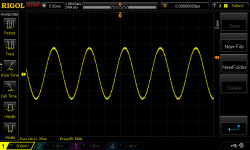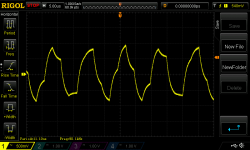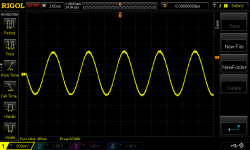All the datasheet filter characteristics are only up to 192kHz. Maybe there really is an issue with higher sampling rates.
I suspect they did nothing to original 192kHz DACs, just disabled any oversampling alltogether for oct and hex, and allowed faster input samplerates.
Have you tried lowering the cut-off of you filter to e.g. 200kHz?
Not yet, as it takes more than just changing constants in software 🙂
bohrok2610: Now you will not like me 🙂
88kHz signal at 192kHz (24.5MHz MCLK) would get directly converted by the DAC to fig 1, but after complicated upsampling to 384kHz (again 24.5MHz MCLK) it gets converted to fig 2. The subsequent analog filter visually fixes the worst, but wide-bandwith analysis would likely show some major 384kHz content.
The DAC's support for higher samplerates is just a marketing crap, IMO.
My motivation was 512kHz samplerate ADC with DAC logically running at the same fs. Now this AKM "feature" is a real game changer. I can "crank up" FSx128 (i.e. the properly working quad) to 460kHz (MCLK 58MHz - look at the pretty 220kHz at DAC output with the sharp filter selected - fig 3). But at 512kHz FS (MCLK 65MHz) the digital filter already hits random errors :-(
88kHz signal at 192kHz (24.5MHz MCLK) would get directly converted by the DAC to fig 1, but after complicated upsampling to 384kHz (again 24.5MHz MCLK) it gets converted to fig 2. The subsequent analog filter visually fixes the worst, but wide-bandwith analysis would likely show some major 384kHz content.
The DAC's support for higher samplerates is just a marketing crap, IMO.
My motivation was 512kHz samplerate ADC with DAC logically running at the same fs. Now this AKM "feature" is a real game changer. I can "crank up" FSx128 (i.e. the properly working quad) to 460kHz (MCLK 58MHz - look at the pretty 220kHz at DAC output with the sharp filter selected - fig 3). But at 512kHz FS (MCLK 65MHz) the digital filter already hits random errors :-(
Attachments
Last edited:
That's my take as well.I suspect they did nothing to original 192kHz DACs, just disabled any oversampling alltogether for oct and hex, and allowed faster input samplerates.
Note this block diagram of the AK439x series:
I would think that for 449x series it's the same basically. The 8x upsampler & FIR filter with 4 (5 for the 4493) available selections and a bypass (forced off for >= quad speed), and the S/H-stage upsampler (this appears to be the mentioned "sample-repeater") now allowing the other factors so that the modulator and SC-DAC core are running still at a proper design rate...
Why?The DAC's support for higher samplerates is just a marketing crap, IMO.
The support for higher sample rates is there. What seems to be missing is the support for 8x digital filter above 192kHz.
Klaus, thanks for the diagram. Where does it come from?
Still I do not understand the figures for 192kHz - in the NOS mode there is no extra added same-value sample visible. Probably I do not understand the very principles, thanks for your patience.
Because at samplerates >192kHz the conversion of identical low-frequency signals yields much worse quality, while normally one would expect the opposite (more samples per period, less work for the analog filter). But that's just my opinion.
Now on to ESS, I suspect the same snake nest 🙂
Still I do not understand the figures for 192kHz - in the NOS mode there is no extra added same-value sample visible. Probably I do not understand the very principles, thanks for your patience.
Why?
Because at samplerates >192kHz the conversion of identical low-frequency signals yields much worse quality, while normally one would expect the opposite (more samples per period, less work for the analog filter). But that's just my opinion.
Now on to ESS, I suspect the same snake nest 🙂
Puh... the SC-DAC is running at MCLK so I expect a series degradation in performance. Plus, no way you can bypass VREFL/H properly for that frequency in the given chip package. The SC-DAC is very(!) sensitive to the exact supply impedance at MCLK... clearly seen with the schematic of SC-DAC core at hand.[...]MCLK 65MHz[...]
The support for higher sample rates is there. What seems to be missing is the support for 8x digital filter above 192kHz.
But is this (IMO correct) conclusion anywhere to be found in the datasheet? It even talks about oct and hex modes, as if they did anything useful. Maybe a short explanation could have been added:
normal -> 8x oversampling
double -> 4x oversampling
quad -> 2x oversampling
oct -> no oversampling
hex -> no oversampling
Anyway, guys, thanks a lot. You have helped me immensely.
Puh... the SC-DAC is running at MCLK so I expect a series degradation in performance. Plus, no way you can bypass VREFL/H properly for that frequency in the given chip package. The SC-DAC is very(!) sensitive to the exact supply impedance at MCLK... clearly seen with the schematic of SC-DAC core at hand.
Does the SC-DAC really run at MCLK? Look at the DAC output zooms in https://www.diyaudio.com/forums/equ...-oversampling-filter-issue-4.html#post6659154 - they show no change for MCLK24.5MHz and 49MHz, the frequency of that "step" was always 12MHz.
Of course I will not run the chip outside its specs, I have to find a different one.
I found that online somewhere, saved it but didn't bookmark.Klaus, thanks for the diagram. Where does it come from?
Best spec ADC Chip currently.... ?? | Page 11 | Audio Science Review (ASR) Forum
Still I do not understand the figures for 192kHz - in the NOS mode there is no extra added same-value sample visible. Probably I do not understand the very principles, thanks for your patience.
Understood. At least for the step from 192kHz to 352.8kHz this could be a concern.Because at samplerates >192kHz the conversion of identical low-frequency signals yields much worse quality, while normally one would expect the opposite (more samples per period, less work for the analog filter). But that's just my opinion.
Well, they should have stated that there are no filters at all in oct and hex modes.
So, the filtering is up to the user, on the analog side, like in the good old days. And it all depends if the imaging is any problem for the application. If the task is precision 200kHz++ sine wave generation (with low distortion and little imaging) then I would agree. For audio, including bat research *) I'd say no.
*) I had to do with that field a while ago, and it is a problem when you want to test frequency sensitivity of the bats in their lower range and the test signal, amp and transducer have high distortion, causing the bats reacting to the harmonics
But I am still totally confused. What does the oversampling actually do?
Technically, it enhances precision, practically, it introduces more distortion.
4490 DS says "The MCLK is used to operate the digital interpolation filter and the delta-sigma modulator.", 4493 says "The MCLK is used to operate the digital interpolation filter and the delta-sigma modulator and the SCF".Does the SC-DAC really run at MCLK? Look at the DAC output zooms in https://www.diyaudio.com/forums/equ...-oversampling-filter-issue-4.html#post6659154 - they show no change for MCLK24.5MHz and 49MHz, the frequency of that "step" was always 12MHz.
Of course they are not telling us if there is a scale factor and it looks like there is one. I also looked at it here and see the 12MHz as well, I wasn't aware of that scale factor before.
Now this makes finally clear why these chips dont like, for example, paralleled 10uF and a 100nF ceramics bypasses on VRFEFH/L. The anti-resonance of that combo in typical SMT packages is exactly in the 12MHz region, and the impedance can reach an Ohm or more. Bingo!
Good luck. But why not use a proper analog filter? At these frequencies LC-filters start to become feasible.Of course I will not run the chip outside its specs, I have to find a different one.
I am glad everyone has gained from this discussion 🙂
If the assignment is e.g. full range 100kHz @-0.1dB => cut-off -3dB at 200-300kHz? That yields very little attenuation at 512kHz while the 512kHz component of the oct mode would be huge.
On the other hand the quad-mode output will most likely peak a bit at 12MHz, that's a very different job for the 200-300kHz analog filter.
The oct mode is a no-go for a precise measurement device, IMO.
But why not use a proper analog filter? At these frequencies LC-filters start to become feasible.
If the assignment is e.g. full range 100kHz @-0.1dB => cut-off -3dB at 200-300kHz? That yields very little attenuation at 512kHz while the 512kHz component of the oct mode would be huge.
On the other hand the quad-mode output will most likely peak a bit at 12MHz, that's a very different job for the 200-300kHz analog filter.
The oct mode is a no-go for a precise measurement device, IMO.
Last edited:
Why would some amount of imaging be a problem when ADC and DAC run the same sample rate? Provided the ADC has proper alias filters (audio ADC don't).
This is what I understood you want to do, right.
This is what I understood you want to do, right.
btw, what's your development platform, with MCLK fully adjustable and such, I'd be keen to know...
Do you have a phase requirement? I'd filter right at 100kHz with a higher order elliptic or Chebycheff and EQ the passband flat digitally in the feed. If required, add analog notches at spot frequencies.If the assignment is e.g. full range 100kHz @-0.1dB => cut-off -3dB at 200-300kHz?
My piece runs fine at 384/49MHz. IMO there is no reason not to, if the chip can run the delta/sigma conversion at 49MHz master clock. It would be unusual that the oversampling filter could oversample 768kHz for the 49MHz MCLK and not the 384kHz.
BTW the support for 384kHz fs with 49.152MHz MCLK is marked as "Not available" in all later AKM dacs (ak4493, ak4497 & ak4499). It probably is not just an error in the datasheets.
Well, I have to say, I was thinking that CS43198 was alone with its poor digital filter for 384 kHz. Apparently Cirrus is just honest in publishing the graph on page 130.
https://statics.cirrus.com/pubs/proDatasheet/CS43198_F1.pdf
https://statics.cirrus.com/pubs/proDatasheet/CS43198_F1.pdf
Probably there isn't any Audio DAC out there with an even only aproximate sinc digital filter at their highest sample rates. The oversampling headroom is available but not the computing power/resources.
Probably there isn't any Audio DAC out there with an even only aproximate sinc digital filter at their highest sample rates. The oversampling headroom is available but not the computing power/resources.
Has no one tested ES90xx or the AK4499 at these rates? I expected the filter to be compromised given the demands, but I didn't expect "NOS" behavior.
I have to apologize to Terry Demol again for dismissing his suggestion of operating PCM1792A at >192 kHz using the external filter mode. The results would probably be much better than this if you used an external 4x OSF to input 1.536 MHz.
- Home
- Design & Build
- Equipment & Tools
- AK4493 at oct/hex sampling speeds - oversampling filter issue?


